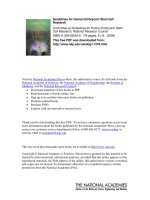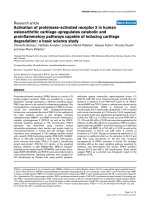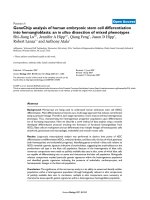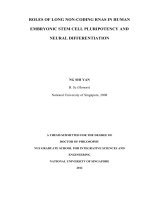Roles of long non coding RNAs in human embryonic stem cell pluripotency and neural differentiation 4
Bạn đang xem bản rút gọn của tài liệu. Xem và tải ngay bản đầy đủ của tài liệu tại đây (5.62 MB, 13 trang )
!
125!
Chapter VIII – Brain lncRNA RMST Regulates
Neurogenesis by Association with SOX2
8.1 Introduction
RMST or rhabdomyosarcoma 2 associated transcript is a long non-coding RNA first
found to be highly expressed in rhabdomyosarcoma, a malignant cancer of the
muscles. More recent studies in mice models, however, uncovered a plausible role of
Rmst in the brain. In a study of Pitx3-GFP knock-in mice, in which the GFP reporter
is targeted into the Pitx3 gene and expressed exclusively in midbrain dopamine
neurons (mDA) and their postmitotic precursors, the authors found Rmst as
differentially upregulated in the Pitx3-GFP
+
(mDA) compared to the Pitx3-GFP
-
cell
population (Uhde et al., 2010). In the developing mouse brain, Rmst expression in the
ventral midbrain was high in the Lmx1a expressing region during E11.5 to E13.5
(Figure 8.1). Lmx1a is a transcription factor that is important for the specification of
mDA neurons during embryogenesis (Andersson et al., 2006; Nakatani et al., 2010),
and is one of the three minimal factors required to reprogram fibroblasts into mDA
neurons (Caiazzo et al., 2011). In the adult mice, Rmst expression is restricted to the
central nervous system (Uhde et al., 2010). Taken together, the study by Uhde and
colleagues showed that Rmst is developmentally regulated and exhibits tissue-specific
expression patterns, which suggest a plausible role in mDA neurogenesis.
!
126!
Figure 8.1: (Reproduced from Uhde et al., 2010) Rmst is highly expressed in the
midbrain and prospective dopamine neurons. Rmst transcript was detected by in
situ hybridization in the mouse embryonic brain. (A, B) Rmst as detected in both thr
roof plate (RP) and the floor plate (FP), as well as in the outermost layer of cells in
the alar plate (ALP) and intermediate zone of the basal plate (BP). (C-F) Rmst
expression during E11.5 to E14.5. (G-J) Lmx1a expression on an adjacent midbrain
section during E11.5 to 14.5. At E14.5, Rmst expression is largely restricted to the
ventral tegmental area (VTA), and not the laterally located substantia nigra (SNc).
In this current study, the human RMST transcript was identified as one of the
neuronal lncRNAs highly expressed in human dopamine neurons, compared to the
hESCs and NPCs from which the neurons were derived from. In Chapter VII, the
indispensable role of RMST in human neurogenesis was confirmed in vitro, by means
of an RNAi approach. Neural progenitors with decreased RMST transcript expression
did not differentiate into TUJ1-expressing neurons, but became glia instead (Figures
7.4 to 7.6). In this chapter, the molecular mechanism of RMST governing
neurogenesis is explored.
!
127!
8.2 Results
8.2.1 RMST is highly expressed in the human brain and upregulated during
neurogenesis
The expression of Rmst in the mouse is restricted to the central nervous system (Uhde
et al., 2010). Given the high level of conservation between mouse and human RMST
transcripts (Chodroff et al., 2010), it was important to determine if a similar tissue-
specific expression was observed in humans. To this end, the expression of RMST was
profiled in a panel of human somatic tissues, as well as in the H1 hESC line (Figure
8.2). RMST expression was found to be very highly and almost exclusively expressed
in the brain tissues in this study, namely the whole brain, fetal brain, cerebellum and
substantia nigra, with the highest expression observed in the substantia nigra, where
mDA neurons are located. This agrees with the observation in the mouse that the
lncRNA is restricted to the central nervous system, particularly in the region where
mDA neurons arises (Uhde et al., 2010).
!
128!
Figure 8.2: Expression of RMST in somatic tissues measured by qPCR. RMST is
highly expressed in the brain tissues, including the whole brain, fetal brain,
cerebellum and substantia nigra, while weakly expressed in the other somatic tissues.
All three isoforms of RMST were detected by qPCR, and relative expression was
normalized to RMST expression in the whole brain sample.
Microarray analysis indicated that RMST was upregulated when NPCs
differentiate into mature neurons. This was confirmed by qPCR in two independent
cell lines: hESC (H1)-derived NPCs and an immortalized human neural stem cell line
ReN-VM. In both hESC-derived cells and ReN-VM cells, RMST expression was
upregulated by approximately 9-fold when the neural progenitors differentiate into
neurons (Figures 8.3A and 8.3B respectively). This indicated that RMST was
consistently upregulated when neural progenitors differentiate into neurons.
!
129!
Figure 8.3: RMST expression is upregulated during neurogenesis. Levels of
RMST were measured by qPCR during neuronal differentiation of neural progenitors.
(A) As H1-derived NPCs (H1-NPCs) differentiate into neurons (H1-Neuron), RMST
expression increased by approximately 9-fold. (B) In an identical experimental setup,
RMST expression increased by more than 8-fold as ReN-VM neural stem cells (ReN-
VM NSCs) differentiate into neurons.
8.2.2 RMST is developmentally regulated by transcription factor REST
RMST is a spliced lncRNA, with 3 alternative isoforms assigned with the following
GenBank IDs: AK056164, AF429305 and AF429306 (Figure 7.1 and Figure 8.4). In
humans, RMST is located on chromosome 12q23, and the ENCODE ChIP-seq data
from human embryonic stem cells (H1) and neuroblastomas (PFSK-1) indicated a
REST binding peak upstream of RMST, suggesting that REST may regulate the
transcription of RMST (Figure 8.4). REST, also known as NRSF or neuronal
restrictive silencing factor, is a transcription factor expressed in neural stem cells and
non-neuronal cells, to repress neuronal gene expression.
To confirm that REST indeed binds upstream of RMST in the neural stem cell
line ReN-VM, REST chromatin-immunoprecipitation (ChIP) was performed. An
!
130!
isotype control IgG ChIP was also performed alongside the REST ChIP to rule out
non-specific chromatin binding. Quantitative PCR of the ChIP DNA revealed REST
occupancy at the region upstream of RMST (pRMST), confirming that REST binds
upstream of RMST in the human neural stem cell line (Figure 8.5). Since transcription
factor binding events may not result in target gene regulation, I performed REST
knockdown, and probed for RMST expression by qPCR 48 hours after transfection of
siRNAs. REST was very efficiently downregulated by at least 80% following
introduction of siRNAs. Following REST knockdown, expression of the lncRNA
RMST was 4-fold upregulated (Figure 8.6). Together with the REST ChIP data, this
indicates that RMST expression is regulated by the repressive transcription factor
REST.
Figure 8.4: ENCODE ChIP-seq database indicates the presence of a REST
binding site upstream of RMST. REST (or NRSF) binding sites were observed
upstream of RMST in three human cell lines, namely GM12878, a lymphoblastoid
cell line, H1 hESCs, and neuroblastoma line PFSK-1. The three isoforms of RMST are
shown as AK056164, AF429305 and AF429306.
!
131!
Figure 8.5: ChIP-PCR indicating REST occupancy upstream of the lncRNA
RMST. REST chromatin immunoprecipitation (ChIP), as well as the isotype IgG
ChIP experiments were performed. Fold enrichment was calculated relative to the IgG
ChIP. Three positive controls, namely RS111, RS625 and RS774, were included in
the study. The promoter region of ELAV1 (pELAV1), not known to be bound by
REST, was included as a negative control. ** indicates a p-value of less than 0.01.
Figure 8.6: RMST expression is regulated by transcription factor REST. REST
was efficiently knocked down by more than 80% by siRNAs. Upon REST
knockdown, RMST expression increased by four-fold. As controls, non-REST targets
showed no change in expression upon REST knockdown, while REST targets SYP and
MAP2 were upregulated. * and ** indicates p-values of <0.05 and <0.01 respectively.
!
132!
8.2.3 RMST is indispensable for neurogenesis, but not required for maintenance
of neuronal identity
The brain-specific expression pattern, and developmental regulation of RMST indicate
functionality. Indeed, this was demonstrated in the loss of neurogenesis upon RMST
knockdown in ReN-VM neural stem cells (Figures 7.4, 7.5 and 8.7). Knockdown of
RMST appeared to shut down the neurogenic program of neural stem cells, with the
cells adopting a glia lineage instead (Figure 7.6). On the other hand, overexpression
of RMST enhanced neuronal differentiation efficiency (Figure 8.8). Taken together,
these results indicate that RMST is indispensable for neurogenesis.
Figure 8.7: Knockdown of RMST prevented neurogenesis. ReN-VM neural stem
cells were transfected with the indicated siRNAs, and TUJ1, a marker for neurons,
was assayed by immunofluorescence 7 days later. In the non-target siRNA (si-NT)
control, TUJ1
+
and MAP2
+
neurons were observed. In RMST knockdown (si-RMST),
there were significantly fewer TUJ1
+
cells, indicating a loss of neurogenesis. The
scale bar indicates 100 µm.
!
133!
Figure 8.8: Overexpression of RMST enhanced neuronal differentiation of ReN-
VM cells. (A) RMST was overexpressed by transfecting the in vitro transcribed RNA
(RMST OE). As a control, total RNA extracted from ReN-VM cells were transfected
(Control OE). Immunostaining of neuronal marker TUJ1 revealed that neuronal
efficiency was increased when RMST was overexpressed. (B) Gene expression
analysis by qPCR indicating that RMST was overexpressed and neuronal markers
were upregulated upon RMST overexpression.
One question that arose was the role of RMST in neurons. Since RMST is
highly expressed in neurons, it is plausible that RMST could play a role in the
maintenance of neuronal identity. To this end, ReN-VM cells were differentiated into
neurons in the N2B27 medium for 7 days, and siRNAs targeting RMST were
subsequently introduced into the neuronal cells by transfection. No morphological
differences were observed in the neurons depleted of RMST, which retained TUJ1 and
synaptophysin (SYP) expression typical of neurons (Figure 8.9). In addition, there
was no significant change in the expression of a panel of neurogenic and neuronal
markers assayed by qPCR (Figure 8.10). Together, this indicated that RMST was
required for neuronal differentiation, but once neuronal identity was attained, the loss
of RMST did not have apparent effects on the neurons.
!
134!
Figure 8.9: Loss of RMST in neurons had no apparent effect on cellular
morphology. A non-target siRNA and siRNA targeting RMST were transfected into
ReN-VM derived neurons. Loss of RMST in the neurons did not have an apparent
effect, as the cells retained the neuronal marker TUJ1, as well as the synaptic protein
SYP.
Figure 8.10: No significant changes in expression of neuronal markers upon
knockdown of RMST in neurons. Expression of neuronal markers was measured by
qPCR. Knockdown of RMST in ReN-VM neurons (dark blue bars) had no significant
effect on expression of early and mature neuronal markers, compared to the non-
target siRNA control (light blue bars).
!
135!
8.2.4 Nuclear-retained RMST physically associates with RNA-binding protein
hnRNPA2B1 and transcription factor SOX2
Previously, RNA fractionation studies indicated that RMST is a nuclear-localized
transcript (Figures 7.7 and 8.11A). To confirm this, RNA fluorescence in-situ
hybridization (RNA-FISH) using a full-length RMST fluorescent probe was used. The
colocalization of the RMST signal and the DAPI stain confirmed that RMST is a
nuclear-localized lncRNA (Figure 8.11B).
Figure 8.11: RMST is a nuclear-localized lncRNA. (A) Cellular RNA was separated
into the nuclear and cytoplasmic fractions by RNA fractionation, and abundance of
the RNA transcripts in either fraction was assayed by qPCR. The nuclear/cytoplasmic
ratio was computed presented in the graph. (B) To confirm that RMST is a nuclear
transcript, RNA fluorescence in situ hybridization (RNA-FISH) was performed, using
a full-length fluorescent probe against RMST.
!
136!
As a nuclear-retained lncRNA, RMST could be physically interacting with
nuclear proteins, which may account for its importance in neurogenesis. In order to
identify protein interaction partners of RMST, biotinylated RNA pulldown was
performed. Briefly, biotin-labeled RNA was generated by in vitro transcription. The
biotin-labeled RNA was then immobilized on streptavidin beads, and subsequently
incubated with pre-cleared nuclear extract from ReN-VM cells. After incubation at 4
°C for 4 hours to allow the formation of protein-RNA complexes, a series of wash
steps were performed and proteins were eventually eluted, ran on an SDS-PAGE gel.
The SDS-PAGE gel was Coomassie-stained, and two protein bands observed in the
RMST pulldown and not in the control RNA pulldowns were then sent for mass
spectrometry. From the mass spectrometry, hnRNPA2B1 and SOX2 were identified
(Figure 8.12). This was then confirmed by Western blot (Figure 8.13), and RNA
immunoprecipitation (RIP) established that RMST could also physically interact with
hnRNPA2 and SOX2 in vivo (Figures 8.14A and 8.14B, respectively). Since an
effective hnRNPA2B1 antibody could not be found for RIP, hnRNPA2-FLAG was
ectopically expressed in ReN-VM cells and RIP was performed using a FLAG
antibody.
!
137!
Figure 8.12: Biotinylated RMST pulldown, coupled to LC-MS/MS mass
spectrometry identified hnRNPA2B1 and SOX2 as protein partners of the
lncRNA. Two additional protein bands corresponding to 37 kDa and 35 kDa were
observed in the RMST pulldown, and not in the controls (beads only and antisense-
RMST, AS-RMST). These bands were excised for mass spectrometry and identified
to be SOX2 and hnRNPA2B1, respectively.









